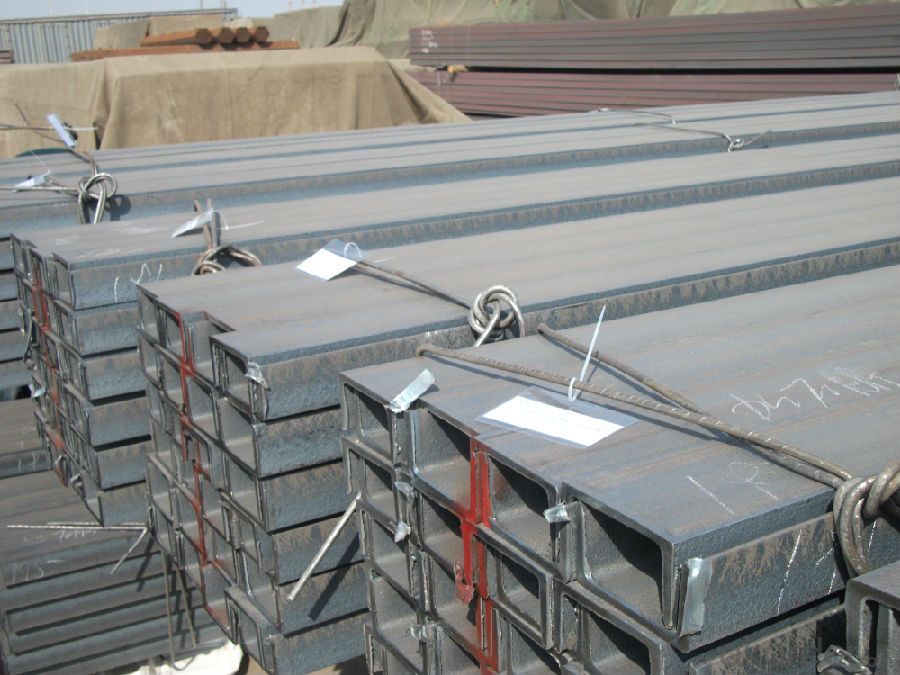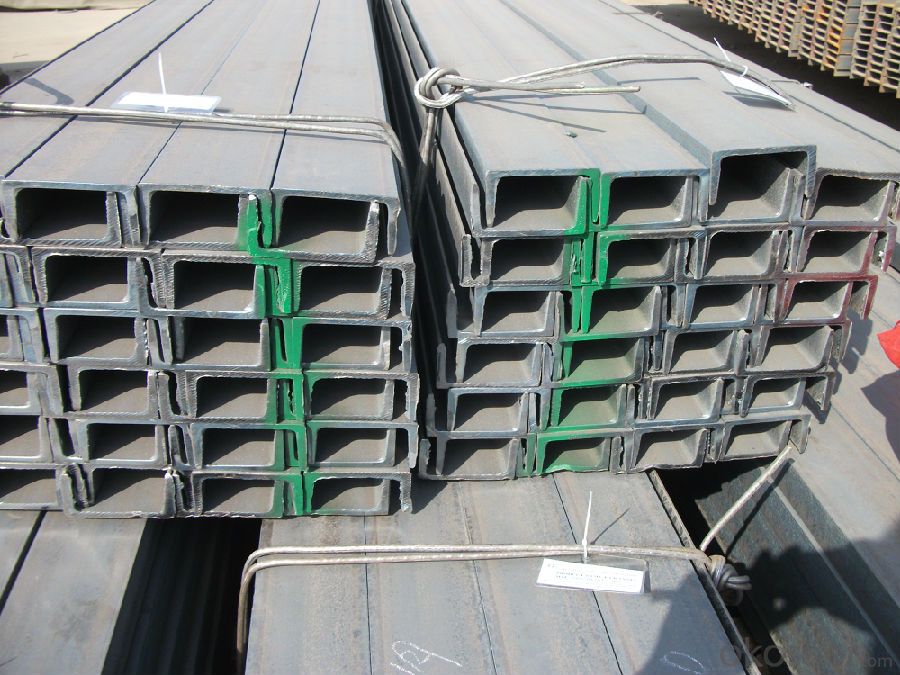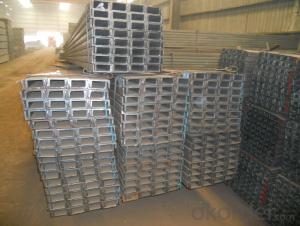U-channel Carbon Steel Hot Rolled JIS Standard High Quality
- Loading Port:
- Tianjin
- Payment Terms:
- TT OR LC
- Min Order Qty:
- 25 m.t.
- Supply Capability:
- 2000 m.t./month
OKorder Service Pledge
OKorder Financial Service
You Might Also Like
Product Description:
OKorder is offering U-channel at great prices with worldwide shipping. Our supplier is a world-class manufacturer of steel, with our products utilized the world over. OKorder annually supplies products to European, North American and Asian markets. We provide quotations within 24 hours of receiving an inquiry and guarantee competitive prices.
Product Applications:
1.The JIS channel can be devided into two kinds, namely common channel steel and light channel steel. The sizes of hot rolled common channel steel range from 5# to 40#. Meanwhile, the channel steel can be divided into cold forming sectional equal channel steel, cold forming sectional unequal channel steel, cold forming inner edge channel steel and outer edge channel steel.
2.The JIS channel is usually used for arch-itechtural structure, and they could be welded in order to support or hang a vari-ety of facilities. They are also usually used in combination with I beam. The channel steel with sizes under 14# is usually applied to construction engineering, as purline, while the channel steel with sizes above 16# is more likely to be used in building vehicle chassis structure and mechanical structure. Furthermore, the channel steel in sizes above 30# are target at building bridge structure, as tension bar.
Product Advantages:
OKorder's U-channel are durable, strong, and resist corrosion.
Main Product Features:
· Premium quality
· Prompt delivery & seaworthy packing (30 days after receiving deposit)
· Corrosion resistance
· Can be recycled and reused
· Mill test certification
· Professional Service
· Competitive pricing
Product Specifications:
1.We are able to provide channel steel of top quality at attractive price.
2.Our products of channel steel have passed ISO9001:2008 Quality Management System Certification.
Alloy No | Grade | Element (%) | |||||
C | Mn | S | P | Si | |||
Q235 | B | 0.12—0.20 | 0.3—0.7 | ≤0.045 | ≤0.045 | ≤0.3 | |
Alloy No | Grade | Yielding strength point( Mpa) | |||||
Thickness (mm) | |||||||
≤16 | >16--40 | >40--60 | >60--100 | ||||
≥ | |||||||
Q235 | B | 235 | 225 | 215 | 205 | ||
Alloy No | Grade | Tensile strength (Mpa) | Elongation after fracture (%) | ||||
Thickness (mm) | |||||||
≤16 | >16--40 | >40--60 | >60--100 | ||||
≥ | |||||||
Q235 | B | 375--500 | 26 | 25 | 24 | 23 | |
FAQ:
Q1: How soon can we receive the product after purchase?
A1: Within three days of placing an order, we will begin production. The specific shipping date is dependent upon international and government factors, but is typically 7 to 10 workdays.
Q2: What makes stainless steel stainless?
A2: Stainless steel must contain at least 10.5 % chromium. It is this element that reacts with the oxygen in the air to form a complex chrome-oxide surface layer that is invisible but strong enough to prevent further oxygen from "staining" (rusting) the surface. Higher levels of chromium and the addition of other alloying elements such as nickel and molybdenum enhance this surface layer and improve the corrosion resistance of the stainless material.
Q3: Can stainless steel rust?
A3: Stainless does not "rust" as you think of regular steel rusting with a red oxide on the surface that flakes off. If you see red rust it is probably due to some iron particles that have contaminated the surface of the stainless steel and it is these iron particles that are rusting. Look at the source of the rusting and see if you can remove it from the surface.
Images:


- Q:How do steel channels contribute to the ease of construction?
- Steel channels contribute to the ease of construction in several ways. Firstly, they provide structural support and stability to various building components. These channels are designed to withstand heavy loads and provide a strong framework for the overall structure. This makes them ideal for use in constructing beams, columns, and joists. Additionally, steel channels are versatile and can be easily customized to meet specific construction requirements. They come in various sizes and shapes, allowing for flexibility in design. This adaptability makes them suitable for a wide range of construction projects, whether it be for industrial buildings, bridges, or residential structures. Moreover, steel channels are lightweight compared to other construction materials, such as concrete. This makes them easier to handle and transport on construction sites, reducing the need for heavy machinery and manpower. The lightweight nature also simplifies the overall construction process and minimizes the time and effort required for installation. Furthermore, steel channels are durable and resistant to various environmental factors, such as corrosion, fire, and termites. This longevity ensures that the structure remains stable and secure over time, reducing the need for frequent repairs or replacements. It also contributes to the overall sustainability of the construction industry by reducing waste and promoting long-term use. In summary, steel channels contribute to the ease of construction by providing structural support, versatility in design, ease of handling, and durability. These qualities make them an essential component in modern construction, improving the overall efficiency and reliability of the construction process.
- Q:How do steel channels contribute to the overall efficiency of a structure?
- Steel channels contribute to the overall efficiency of a structure by providing strength, stability, and support. They are commonly used as structural members in various applications such as building frames, bridges, and industrial equipment. The shape of steel channels allows for efficient distribution of loads, reducing the amount of material required and minimizing the weight of the structure. Additionally, their high strength-to-weight ratio enables them to withstand heavy loads and resist bending or twisting, ensuring the longevity and durability of the structure. Furthermore, steel channels can be easily fabricated, assembled, and connected, making construction faster and more cost-effective. Overall, the use of steel channels enhances the structural integrity and efficiency of a building or infrastructure project.
- Q:What are the guidelines for steel channel installation in corrosive environments?
- When installing steel channels in corrosive environments, there are a few important guidelines to follow to ensure their longevity and effectiveness: 1. Material selection: Choose a steel material that is specifically designed to withstand corrosive environments. Stainless steel is often a suitable choice due to its high resistance to corrosion. Additionally, consider the grade of stainless steel that is most appropriate for the specific corrosive substances present in the environment. 2. Surface preparation: Properly prepare the surface of the steel channels before installation. This may involve removing any existing rust or corrosion, cleaning the surface thoroughly, and applying a protective coating or treatment to enhance the corrosion resistance. 3. Protective coatings: Apply suitable protective coatings to the steel channels to prevent corrosion. This could include paints, epoxy coatings, or galvanizing. Ensure that the chosen coating is compatible with the corrosive environment and offers long-term protection. 4. Proper drainage: Design the installation in a way that promotes proper drainage of any corrosive substances that may come into contact with the steel channels. This can help minimize the accumulation of corrosive agents and reduce the risk of corrosion. 5. Avoid contact with dissimilar metals: Avoid direct contact between the steel channels and dissimilar metals, as this can lead to galvanic corrosion. If contact cannot be avoided, use appropriate insulating materials or coatings to separate the metals and prevent galvanic corrosion. 6. Regular maintenance: Regularly inspect and maintain the steel channels to identify any signs of corrosion or damage. Promptly address any issues to prevent further deterioration and ensure the continued effectiveness of the installation. 7. Follow industry standards and recommendations: Familiarize yourself with relevant industry standards, guidelines, and recommendations for installing steel channels in corrosive environments. This can provide valuable insights on best practices and ensure compliance with safety and performance requirements. It is important to consult with experts or engineers who specialize in corrosion control to ensure that the guidelines are tailored to the specific corrosive environment and the intended application of the steel channels.
- Q:How are steel channels measured?
- Steel channels are typically measured using two key dimensions: the height and the width. The height refers to the vertical measurement from the top to the bottom of the channel, while the width refers to the horizontal measurement from one side to the other. These dimensions are important as they determine the size and shape of the channel, which in turn affects its strength and load-bearing capacity. Additionally, the thickness of the steel used to make the channel is also considered when measuring it. This measurement is usually given in gauge or millimeters and represents the thickness of the steel walls of the channel. By knowing the height, width, and thickness, one can determine the overall dimensions and characteristics of a steel channel, enabling it to be used effectively in various construction and manufacturing applications.
- Q:How do steel channels perform under static loads?
- Steel channels are structural components that are commonly used in construction and engineering applications. When subjected to static loads, such as the weight of a structure or equipment resting on them, steel channels exhibit excellent performance. One key advantage of steel channels is their high strength-to-weight ratio. This means that they can support heavy loads while being relatively lightweight themselves. Steel is known for its exceptional strength and durability, and this property is reflected in the performance of steel channels under static loads. Steel channels also have good resistance to deformation and deflection. When a static load is applied, the channels distribute the load evenly and resist bending or sagging. This ensures the stability and integrity of the structure or equipment being supported. Furthermore, steel channels are highly resistant to corrosion and environmental factors. This makes them suitable for use in various conditions, including outdoor and industrial environments. Their resistance to corrosion also contributes to their long lifespan and low maintenance requirements. In addition to their mechanical properties, steel channels can be easily fabricated and installed. They are available in a wide range of sizes and dimensions, allowing for flexibility in design and construction. Steel channels can be welded or bolted together, providing a secure and reliable connection. Overall, steel channels offer excellent performance under static loads. Their high strength, resistance to deformation, and durability make them a reliable choice for supporting structures and equipment.
- Q:What are the different types of welding techniques used for steel channels?
- There are several different types of welding techniques used for steel channels, including shielded metal arc welding (SMAW), gas metal arc welding (GMAW), flux-cored arc welding (FCAW), and submerged arc welding (SAW). Each method has its own advantages and is chosen based on factors such as the thickness of the steel, the desired weld strength, and the specific application requirements.
- Q:Can steel channels be used in curved structures?
- Curved structures can indeed accommodate the use of steel channels. The versatility of steel channels allows for bending or curving them to meet specific design requirements. This is achievable due to the malleability of steel and the availability of diverse bending techniques. The process entails heating the steel channel to a specific temperature, which increases its pliability. Subsequently, specialized machinery is employed to bend it into the desired curvature. By incorporating steel channels into curved structures, architects and engineers can achieve distinctive and visually appealing designs while ensuring the building's structural integrity remains uncompromised.
- Q:Are steel channels suitable for seismic zones?
- Yes, steel channels are suitable for seismic zones. Steel is a strong and ductile material that can effectively resist seismic forces. Steel channels are commonly used in seismic design and construction due to their ability to provide structural stability and resilience during earthquakes. They offer excellent strength-to-weight ratio, flexibility, and resistance to bending and shearing forces, making them a reliable choice for seismic zone applications.
- Q:Are steel channels suitable for use in underground structures?
- Underground structures can benefit from the use of steel channels. These channels are frequently employed in construction due to their strength, durability, and versatility. When it comes to structures located underground, like tunnels or underground parking lots, steel channels offer several advantages. Firstly, steel channels possess a high load-bearing capacity. Robust support systems are typically necessary for underground structures to endure the pressure from surrounding soil or water. Steel channels are capable of evenly distributing the load, providing structural stability and preventing deformation or collapse. Secondly, steel channels are resistant to corrosion, which is particularly crucial in underground environments where moisture and high humidity levels are prevalent. Corrosion can weaken the structural integrity of materials, but steel channels coated with protective substances or constructed from stainless steel can withstand the harsh underground conditions. Additionally, steel channels can be easily fabricated and adjusted to meet specific design requirements, making them ideal for complex underground structures. They can be cut, welded, and shaped to fit various architectural needs, ensuring efficient installation and customization. Lastly, steel channels have a long lifespan and require minimal maintenance, reducing the overall cost and effort associated with underground structures. The durability of steel channels ensures that underground construction remains intact for an extended period, minimizing the need for repairs or replacements. In conclusion, steel channels are a suitable option for use in underground structures due to their strength, corrosion resistance, adaptability, and durability. These qualities make them an excellent choice for providing structural support and ensuring the longevity of underground constructions.
- Q:Are steel channels compatible with other building materials?
- Steel channels, when it comes to other building materials, are indeed compatible. In construction projects, steel channels are frequently employed as structural support elements and can be effortlessly integrated with various building materials like concrete, wood, and even other metals. To illustrate, steel channels can be incorporated into concrete structures to provide supplementary reinforcement and strength. In a building's framework, they can also serve to connect and support wooden beams or trusses. Furthermore, steel channels can be joined together with other steel components through welding or bolting, enabling the creation of intricate and adaptable structures. This compatibility with other building materials has made steel channels a favored option in construction projects, as they can readily be combined with different materials to meet specific design and engineering requirements.
1. Manufacturer Overview |
|
|---|---|
| Location | |
| Year Established | |
| Annual Output Value | |
| Main Markets | |
| Company Certifications | |
2. Manufacturer Certificates |
|
|---|---|
| a) Certification Name | |
| Range | |
| Reference | |
| Validity Period | |
3. Manufacturer Capability |
|
|---|---|
| a)Trade Capacity | |
| Nearest Port | |
| Export Percentage | |
| No.of Employees in Trade Department | |
| Language Spoken: | |
| b)Factory Information | |
| Factory Size: | |
| No. of Production Lines | |
| Contract Manufacturing | |
| Product Price Range | |
Send your message to us
U-channel Carbon Steel Hot Rolled JIS Standard High Quality
- Loading Port:
- Tianjin
- Payment Terms:
- TT OR LC
- Min Order Qty:
- 25 m.t.
- Supply Capability:
- 2000 m.t./month
OKorder Service Pledge
OKorder Financial Service
Similar products
New products
Hot products
Related keywords




























